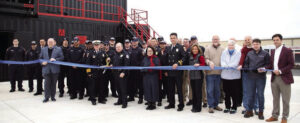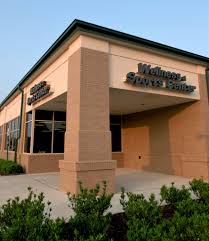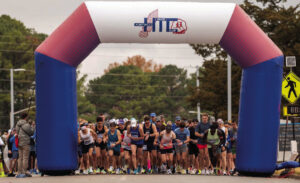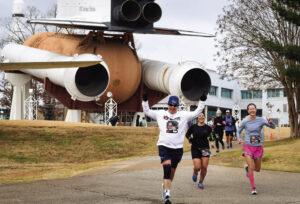SLS oxygen tank tested beyond limits at Marshall Space Flight Center in prep for launch
HUNTSVILLE – On Wednesday, engineers completed the Space Launch System (SLS) rocket’s structural testing campaign for the Artemis lunar missions by testing the liquid oxygen structural test article to find its point of failure.
“The Space Launch System and Marshall test team have done a tremendous job of accomplishing this test program, marking a major milestone not only for the SLS Program but also for the Artemis program,” said John Honeycutt, the SLS Program Manager. “From building the test stands, support equipment and test articles to conducting the tests and analyzing the data, it is remarkable work that will help send astronauts to the Moon.”
For the final test, the liquid oxygen tank test article — measuring 70 feet tall and 28 feet in diameter — was bolted into a massive 185,000-pound steel ring at the base of Marshall’s Test Stand 4697. Hydraulic cylinders were then calibrated and positioned all along the tank to apply millions of pounds of crippling force from all sides while engineers measured and recorded the effects of the launch and flight forces. The liquid oxygen tank circumferentially failed in the weld location as engineers predicted and at the approximate load levels expected, proving flight readiness and providing critical data for the tank’s designers. The test concluded at approximately 9 p.m. This final test to failure on the LOX STA met all the program milestones.
The successful completion of SLS structural qualification testing at NASA’s Marshall Space Flight Center in Huntsville, Alabama wraps up the largest test campaign at the center since tests conducted for the Space Shuttle Program, more than 30 years ago. During the test campaign five structural test articles underwent 199 separate test cases and more than 421 gigabytes of data were collected to add to computer models used to design the rocket. The final test marks the achievement of all SLS structural testing requirements prior to the Artemis I mission — the first in a series of increasingly complex missions that will enable human exploration to the Moon and Mars.
Earlier this year, NASA and engineers from Boeing, the core stage prime contractor, completed 24 baseline tests that simulated actual flight conditions on the liquid oxygen structural test article. For all the tests, thousands of sensors measure stress, pressure and temperature while high-speed cameras and microphones sought to identify any buckling or cracking in the tank’s cylindrical wall. The data gathered from this baseline test helped qualify the SLS core stage structures and integrated upper stage for flight.
The Marshall team has been conducting structural qualification testing on the rocket since May 2017 with an integrated test of the upper part of the rocket stacked together — including the interim cryogenic propulsion stage, the Orion stage adapter and the launch vehicle stage adapter. That was followed by testing of the four largest structures that compose the core stage — the engine section, the intertank, the liquid hydrogen tank and the liquid oxygen tank. Each of these tests provided additional data to computer models that predict how the structures will perform under the harsh conditions of launch and flight.
“The Marshall test lab team has worked closely with the Space Launch System Program to test the rocket’s structures from the top to bottom,” said Ralph Carruth, Marshall’s test lab director. “After watching the test stands being built, working alongside SLS and Boeing engineers to establish testing procedures and conducting and gathering results of five structural qualifying tests, we are proud to contribute data shows these structures can withstand the rigors of flight.”
With the conclusion of testing, designers now have data that may be helpful in optimizing SLS hardware. SLS will have the power to send astronauts forward to the Moon and ultimately to Mars. Testing the new, complex pieces of hardware is critical to the success not only of the first flight test of SLS and NASA’s Orion spacecraft, but also to all future missions.
“This year is a landmark year for core stage testing for the Artemis missions,” said Julie Bassler, the SLS stages manager. “We have successfully completed our core stage major structural tests at Marshall Space Flight Center and are making progress on Green Run testing of the Artemis I core stage at Stennis Space Center that will simulate launch. All these tests are not only valuable for the first Artemis mission but also validates the new integrated design of the SLS core stage structure, propulsion and avionics systems and ensures its readiness for future flights.”















